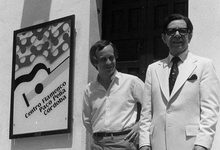Sabicas
| Sabicas | |
|---|---|

Paco Peña and Sabicas
|
|
| Background information | |
| Born | 16 March 1912 |
| Origin | Pamplona, Spain |
| Died | 14 April 1990 |
| Genres | Flamenco music |
| Occupation(s) | |
| Instruments | Guitar |
| Labels | |
| Associated acts | Carmen Amaya |
Sabicas (proper name: Agustín Castellón Campos) (16 March 1912 – 14 April 1990) was a flamenco guitarist of Romani origin.
Sabicas was born in Pamplona, Spain, and began playing guitar at the age of four and made his performing debut two years later. His early style was influenced by Ramón Montoya, to whom he was related on his mother's side of the family. Extensive collaboration with important cantaores (male flamenco singers) of the period helped him develop his personal style.
Leaving Spain in 1936 during the Spanish Civil War, he went into exile in South America with bailaora (dancer) Carmen Amaya. He lived in Mexico City, married Esperanza González Erazo and had four children: Maricruz 1944, Carlos 1946, Agustine 1952 and Margaret 1956. Agustine and Margaret live in New York City, Maricruz lives in Alaska, and Carlos is deceased. Amaya and Sabicas toured together several times. Sabicas later settled in New York City in the United States where he formed a life-long friendship and business association with classical guitarist Rolando Valdés-Blain. He did not return to his native Spain until 1967.
Sabicas was instrumental in the introduction of flamenco to audiences outside of Spain and the Spanish-speaking world. He was probably best known for his technical skills: blazingly fast picados (scales), fast arpeggios, quality composition for the many forms of flamenco, and infallible rhythm, which was critical when playing with a dancer. He was also considered to have perfect pitch. "The finest technique around has got to be Sabicas, the flamenco player," Chet Atkins told Guitar Player Magazine in March 1972.
Sabicas was one of flamenco's greatest guitarists, not only as a technician, but also as a composer. He played flamenco at a previously unimaginable level and created new techniques, opening up new possibilities for the solo instrument. He brought his art to concert halls and major theaters, making it available to all classes. Modern players such as Paco de Lucía, Tomatito, Serranito, René Heredia, Juan Manuel Cañizares, El Viejín, Vicente Amigo, Gerardo Nuñez, Javier Conde and many more acknowledge the great influence of Sabicas's music.
...
Wikipedia
